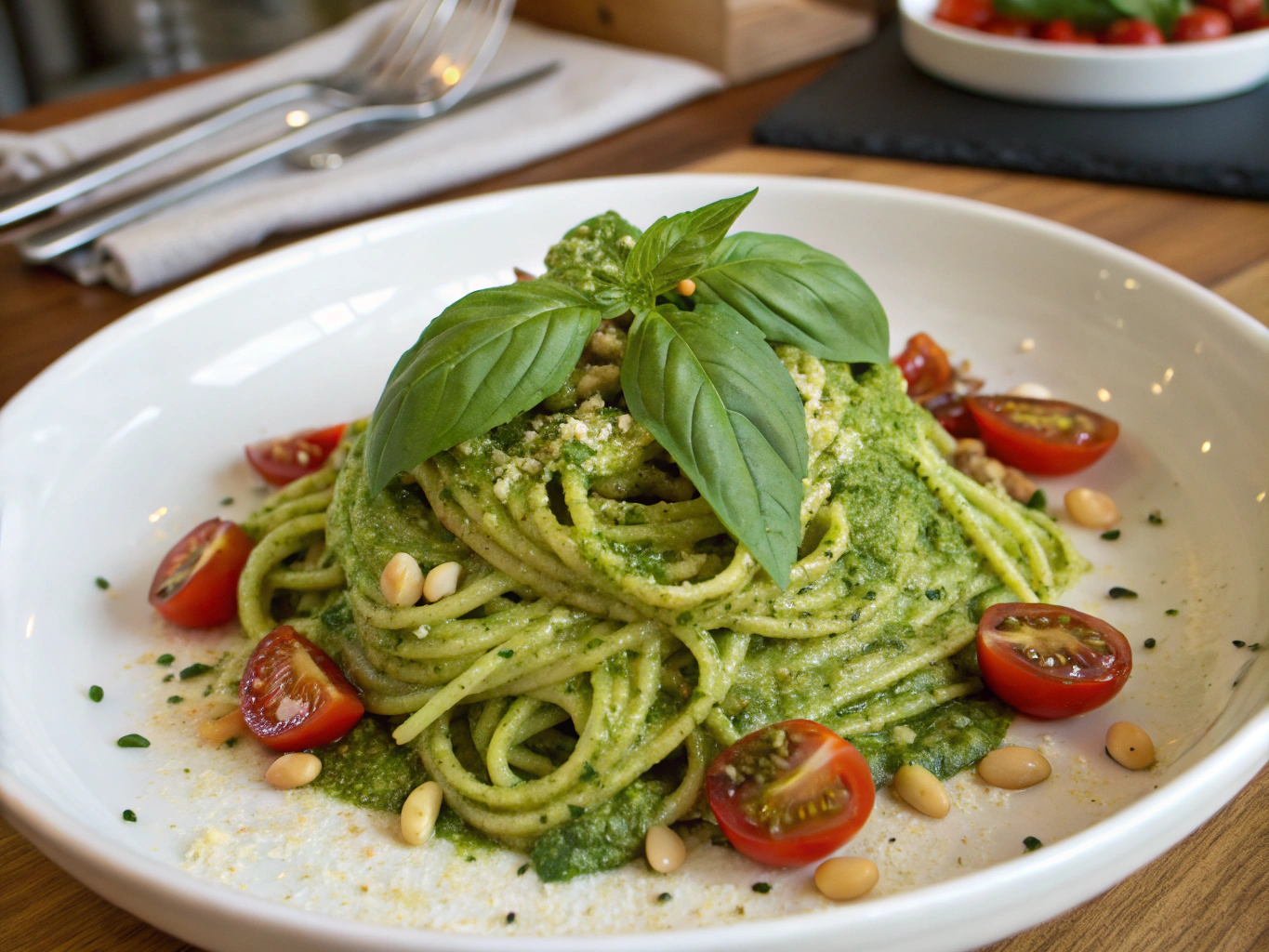
If there’s one dish that instantly transports me back to the sun-soaked counters of my grandmother’s kitchen, it’s pesto pasta. This recipe captures everything I love about cooking: comfort, ease, and bold flavor packed into every bite. In this article, we’ll dive into exactly what makes pesto pasta a weeknight hero. From fresh basil blends to versatility with proteins and veggies, there’s more to pesto than a swirl of green. You’ll learn how to build a crave-worthy dish using pantry basics, with helpful tips, flavor-forward variations, and answers to common pesto pasta questions.
Let’s roll up our sleeves.
The Heart of Pesto Pasta
A Charleston Kitchen Story: Where It All Began
When I was a kid growing up in Charleston, the hum of the food processor meant one thing—fresh pesto was on the way. My grandmother didn’t measure a thing. Basil by instinct, garlic by heart, Parmesan in clouds. And I watched, wide-eyed, as she folded that vivid green sauce into warm pasta until it coated each noodle like velvet. That memory stuck. Years later, I’m still perfecting my own version of her pesto pasta with a signature twist—simple ingredients, but always layered with love and a dash of curiosity.
Pesto pasta has a surprising way of turning modest ingredients into a satisfying, vibrant dish. It’s where classic meets contemporary—a blank canvas for creativity. Whether you go traditional with rigatoni or branch out with lentil noodles, the end result is always something familiar yet fresh. And you don’t need fancy gadgets. A blender and a good wooden spoon will do.
I’ve adapted this classic many ways: adding blistered cherry tomatoes, searing shrimp until golden, or tossing in steamed kale for color and fiber. The beauty of pesto pasta is that it’s endlessly flexible and always fast. It’s a go-to for those smoky late nights when time is tight but comfort is needed.
So whether you’re new to pesto or looking to level up your favorite weeknight dish, I’m walking you through exactly how to make pesto pasta that tastes homemade—because it is. The better the ingredients, the brighter the bowl. Let’s make pesto pasta your new fridge-clearing hero.
Why Pesto Pasta Works Anytime, All the Time
It’s not just heritage that makes pesto pasta shine; it’s also the unbeatable balance: creamy oil, sharp cheese, herbaceous basil, and the nuttiness of pine nuts or alternatives. Each bite hits every note—savory, fresh, bright. With pesto as the base, you’ve got a sauce that clings like a dream, stores well, and plays nicely with leftovers.
Pesto pasta also happens to be one of the easiest recipes to make vegetarian or even vegan. Switch the cheese, swap the nuts, and you’re good to go. In fact, on this guide to plant-based pasta sauces, I dive deeper into how to adapt classics like this to suit any diet.
Whether you’re prepping dinner after little league or hosting a laid-back Friday dinner, pesto pasta delivers. It cooks quickly and fits many palettes. Throw in some roasted veggies or fold in grilled chicken, and it transforms easily from side dish to centerpiece.
Even on the busiest of nights, pesto pasta reminds me of the calming rhythm of stirring, tasting, tweaking. It’s a dish that doesn’t ask for much but gives back tenfold.
How to Make the Best Pesto Pasta at Home
Ingredients List: Classics, Substitutions & Flavor Boosters
You only need a few ingredients to make amazing pesto pasta, and chances are, you already have most in your kitchen. Here’s the magic combo:
| Ingredient | Details & Swaps |
|---|---|
| Pasta | Short pasta like penne, fusilli, or rigatoni works best for holding sauce; gluten-free or legume-based pastas also shine. |
| Fresh Basil | Sweet basil preferred. In cooler months, add some spinach or kale for color and bulk. |
| Garlic | One clove goes far; roast it first for mellower flavor if desired. |
| Parmesan Cheese | Use fresh grated Parmigiano-Reggiano or nutritional yeast for vegan version. |
| Pine Nuts | Toast first for depth; swap with sunflower seeds, walnuts, or almonds for budget-friendly options. |
| Extra Virgin Olive Oil | Adds lush body; use high-quality cold-pressed for best results. |
Optional add-ins: cooked chicken, sautéed mushrooms, roasted red peppers, or even a spoonful of this roasted tomato confit stirred through.
Timing: Quick, Simple, Ready in a Flash
Time is always a factor, and with pesto pasta, you won’t wait long:
- Prep time: 10 minutes
- Cook time: 12 minutes
- Total time: 22 minutes
That’s about 20% less than most creamy or tomato-based recipes. It’s quick enough for a weeknight rescue but flavorful enough for a small dinner party.
Step-by-Step Instructions: MacMar Style
- Cook pasta in generously salted water until al dente (don’t overcook—it keeps the texture lively).
- While pasta cooks, blend basil, garlic, toasted nuts, cheese, and a splash of oil in a food processor.
- Slowly pour in remaining olive oil while blending until creamy and spoonable. Taste and adjust salt or cheese as needed.
- When pasta is ready, reserve ½ cup of pasta water, then drain.
- Toss hot pasta with fresh pesto, adding reserved pasta water as needed to loosen and coat evenly.
- Finish with cracked black pepper, an extra sprinkle of cheese, or a squeeze of lemon for brightness.
Want to keep it extra fresh? Store leftover pesto in an airtight jar and top it with a thin layer of olive oil to preserve color and flavor.
As confirmed by USDA guidelines on safe refrigeration times, pesto will keep safely in the fridge for up to 5 days.
Next-Level Tips for the Perfect Pesto Pasta
Protein Pairings, Veggie Blends & Creative Upgrades
Taking your pesto pasta up a notch doesn’t require complexity—just some thoughtful twists. Pair it with:
- Pan-seared scallops or sautéed shrimp
- Roasted broccoli or asparagus
- Sun-dried tomatoes for a tangy punch
- Grilled tofu or chickpeas for a protein kick
One of my favorite combos? Tossing in roasted zucchini cubes and crispy capers to add creamy and salty contrasts. Or, make a cold version by turning this into a pesto pasta salad with cherry tomatoes and mozzarella cubes.
Over at this zesty quinoa and sweet potato bowl, I use pesto to add depth—proof that this versatile sauce goes far beyond pasta.
MacMar’s Technique Troubleshooting
If your pesto pasta is too thick—add a touch more pasta water. Too thin? Stir in a tablespoon of grated cheese. Favored herb too strong? Blend in extra spinach or parsley to balance it out.
Don’t be afraid to tweak and taste. And always toast your nuts. It brings warmth and makes the flavors sing.
Remember, pesto oxidizes quickly. If you’re not serving right away, add a little lemon juice in the pesto blend—it brightens the flavor and delays browning.
Want extra creaminess? Add a dollop of ricotta or Greek yogurt at the last toss.
Storing, Serving & Common Pesto Pasta Pitfalls
How to Store + Reheat without Losing Flavor
- Store leftovers in an airtight container. Add a light drizzle of olive oil on top to seal in color.
- To reheat, gently warm pasta on stove with 1–2 tablespoons of water to revive the sauce. Avoid the microwave when possible—it can make the pasta gummy.
- Make it ahead: pesto freezes well. Use ice cube trays for portioning and thaw what you need.
Got too much basil? Blend and freeze extra pesto base without cheese. Stir in cheese after defrosting for best texture. You can read more about batch cooking and freezer prep tips here.
What to Serve with Pesto Pasta
Complete the meal with sides that match pesto pasta’s brightness:
- Garlic bread or rustic toast
- Arugula salad with balsamic vinaigrette
- Roasted carrots and sweet potatoes
- Glass of crisp Pinot Grigio or light cucumber-lime water
Pesto pasta plays well with rustic, simple accompaniments. Bring it to potlucks with confidence—it travels well warm or cold.
FAQs about Pesto Pasta
What goes well in pesto pasta?
Pesto pasta pairs great with grilled chicken, cherry tomatoes, shrimp, arugula, sun-dried tomatoes, or roasted veggies like zucchini and asparagus.
Can I just add pesto to my pasta?
Yes, but it’s best to add a splash of reserved pasta water to help the pesto coat evenly and give a smoother consistency.
What is pesto pasta made of?
Pesto pasta is made with pasta tossed in pesto sauce—a blend of basil, garlic, Parmesan cheese, olive oil, and nuts like pine nuts or walnuts.
How do you use pesto from a jar for pasta?
Warm your jarred pesto slightly and toss it with just-cooked pasta and a bit of starchy pasta water. This helps the sauce emulsify and stick.
Conclusion: Your New Favorite Weeknight Hero
Pesto pasta isn’t just a meal—it’s a mood. It’s the smell of fresh basil blitzing in a blender, the steam of just-drained noodles, the joy of tossing a sauce you made from scratch. Whether you’re in my Charleston kitchen or yours, this recipe is an invitation—to slow down, laugh, taste as you go, and maybe even try something new.
At FlavivoRecipes.com, you’ll find more blends of modern flavor and old-school comfort like this roasted butternut squash pasta or a cozy lentil Bolognese. And if you’re ever unsure where to start, I’m here—pots clanking and wooden spoon in hand—to guide you with curiosity, patience, and just enough spice.
